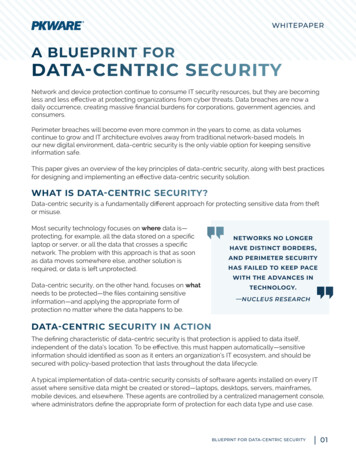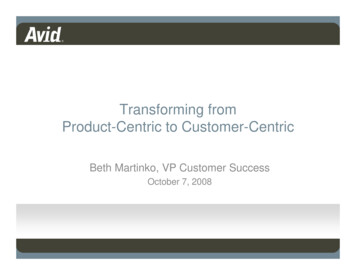
Transcription
WHITEPAPERA BLUEPRINT FORDATA-CENTRIC SECURITYNetwork and device protection continue to consume IT security resources, but they are becomingless and less effective at protecting organizations from cyber threats. Data breaches are now adaily occurrence, creating massive financial burdens for corporations, government agencies, andconsumers.Perimeter breaches will become even more common in the years to come, as data volumescontinue to grow and IT architecture evolves away from traditional network-based models. Inour new digital environment, data-centric security is the only viable option for keeping sensitiveinformation safe.This paper gives an overview of the key principles of data-centric security, along with best practicesfor designing and implementing an effective data-centric security solution.WHAT IS DATA-CENTRIC SECURITY?Data-centric security is a fundamentally different approach for protecting sensitive data from theftor misuse.Most security technology focuses on where data is—protecting, for example, all the data stored on a specificlaptop or server, or all the data that crosses a specificnetwork. The problem with this approach is that as soonas data moves somewhere else, another solution isrequired, or data is left unprotected.NETWORKS NO LONGERHAVE DISTINCT BORDERS,AND PERIMETER SECURITYHAS FAILED TO KEEP PACEWITH THE ADVANCES INData-centric security, on the other hand, focuses on whatneeds to be protected—the files containing sensitiveinformation—and applying the appropriate form ofprotection no matter where the data happens to be.TECHNOLOGY.—NUCLEUS RESEARCHDATA-CENTRIC SECURITY IN ACTIONThe defining characteristic of data-centric security is that protection is applied to data itself,independent of the data’s location. To be effective, this must happen automatically—sensitiveinformation should identified as soon as it enters an organization’s IT ecosystem, and should besecured with policy-based protection that lasts throughout the data lifecycle.A typical implementation of data-centric security consists of software agents installed on every ITasset where sensitive data might be created or stored—laptops, desktops, servers, mainframes,mobile devices, and elsewhere. These agents are controlled by a centralized management console,where administrators define the appropriate form of protection for each data type and use case.BLUEPRNT FOR DATA-CENTRIC SECURITY01
Each time a file is created or modified, the system scans the file to determine whether it containssensitive information, and automatically applies the appropriate protection. End users may begiven the ability to modify these actions manually, but are otherwise not involved in the process.Protected data remains available to authorized users, but cannot be accessed by unauthorizedusers, even when files travel outside the company network.When implemented on an organization-wide scale, data-centric security reduces or eliminates theimpact when network and device protections inevitably fail, while at the same time removing datasilos and other internal obstacles.KEY PRINCIPLES OF DATA-CENTRIC SECURITYEach organization requires a unique solution—one tailored to fit the company’s threat exposureand business needs. However, all successful implementations of data-centric security have certaincharacteristics in common: they’re tightly controlled from a centralized management system, theyprovide coverage across the entire organization without security gaps, they rely on automationrather than manual intervention, and they’re adaptable enough to grow and change along with theorganization.Every data-centric security solution must be designed with these key principles in mind, or thefinished product will fall short of its goals.Centralized ControlCentralized management is essential to ensure that data is protected according to theorganization’s security policies, and that data remains available for appropriate use.Most organizations, even those that have not adopted the data-centric model, already have somedata-level protection in place. Typically, this takes the form of user-applied file encryption—whenemployees encrypt files with passwords before sharing them with colleagues or external recipients.Though very common, this approach creates three significant problems:yy Employees might neglect to apply protection when it’s needed, or might choose methodsthat don’t provide adequate protection.yy When they do encrypt their files, employees must then find a way to share the passwords(the encryption keys) with the recipients, which typically requires the use of unencryptedemail or another unsecure method.yy User-applied encryption leaves employees, rather than administrators, in control ofencryption keys. When keys are not available (for example, when employees fail to sharethem, forget them, or leave the company without providing them), the organization canpermanently lose access to critical data.When properly implemented, data-centric security gives the organization complete control over itssensitive data from the moment that each file or database record is created. Access to protecteddata can be granted or revoked at any time, and all activity is logged for auditing and reporting.02PKWARE
Gapless ProtectionNetwork-centric and device-centric securitystrategies inevitably leave gaps between protectedsystems, because data has to be decrypted orotherwise stripped of protection before it can betransferred between operating systems or platforms.Even experienced security managers can beunaware that sensitive information is being sent orstored without protection. Hackers and maliciousinsiders, however, are adept at finding and exploitingthese gaps.POLICIES, RULES & WORKFLOWSEffective data-centric security eliminates securitygaps, keeping sensitive information protectedeverywhere it’s shared or stored. This is only possiblewhen a data protection solution provides both of thefollowing:POLICIES are written documents thatdefine an organization’s standards andgoals for data security.yy Persistent protection that travels with files,even when they are sent outside the companynetwork.yy Cross-platform operability that allows theorganization to protect files (and make themavailable for authorized use) on every operatingsystem within its IT architecture.AutomationAutomated workflows are the key to success indata-centric security. End users do have a part toplay in protecting an organization’s information, butthey should not be expected to shoulder the burdenof evaluating and securing the large and constantlygrowing volumes of data they handle each day.Automation takes user error out of the equation,and allows employees to do their jobs withoutinterruption and without jeopardizing the company’sdata.An organization’s security technology must apply itsdata protection policies in real time, across the entireenterprise, without user intervention. This requirestechnology that continuously monitors file activity,and automatically applies the appropriate protectionas soon as sensitive data appears.As in any rapidly-evolving industry,cybersecurity’s vocabulary is alwayschanging. However, the following terms arecommonly used to describe the distinctionsbetween an organization’s high-levelsecurity requirements and the ways thoserequirements can be implemented in the “realworld” of the organization’s IT ecosystem.Without automated technology, anorganization must rely on employees toremember and follow its data securitypolicies.RULES are specific software configurationsthat apply an organization’s policies todifferent use cases.For example, if an organization’s writtenpolicy states that all files containing creditcard numbers must be encrypted, it cancreate rules in its software to specifywhich devices and locations need tobe monitored for files containing cardnumbers, and which encryption methodsand keys should be used to protect them.WORKFLOWS are the internal processesused by software to carry out the actionsspecified by rules.Workflows describe each step taken bya system in a given use case, includingmonitoring file activity, scanning forsensitive data, applying classification tags,and applying encryption or other forms ofprotection.A BLUEPRINT FOR DATA-CENTRIC SECURITY03
AdaptabilityData-centric security is not a “one size fits all” proposition. Within a single organization, there can bedozens of security policies, hundreds of data types, and thousands of use cases. Some data mightrequire encryption, while other data may need to be masked, deleted, quarantined, or left as is.An effective security strategy will be tailored to meet the organization’s unique requirements, whileaccommodating changes in those requirements over time. Organizations must have confidencethat they can add and remove infrastructure, change business processes, and create newpartnerships, without having to rebuild their data security solution each time.BEFORE YOU BUILDIn order to design a successful data-centric security solution, an organization needs a thoroughunderstanding of its data risks and business needs. The more an organization knows about its dataand the threats facing it, the more able it will be to keep data safe from misuse, while allowing filesto move freely between authorized users.A detailed data risk assessment, followed by a review of existing security policies, will allow yourorganization to get the maximum value for its investment in data-centric security.Conduct a Data Risk AssessmentRisk assessments are a fundamental step in any cybersecurity effort, and are called for in a varietyof guidelines and mandates, including the National Institute of Standards and Technology’scybersecurity framework, and New York’s cybersecurity law for financial services companies.Even if your organization has conducted cyber risk assessments in the past, it’s best to make a freshassessment before beginning a data-centric security implementation. This will ensure that youaccount for any recent changes to IT infrastructure or business processes, and identify any dataspecific issues that may not have been documented in previous assessments.Specifically, your data risk assessment should focus on the following elements:yy The types of data being created and acquired by users, applications, and automatedprocessesyy The use cases for each type of data and each user groupyy The risks associated with each data type and use caseyy The role and effectiveness of any existing data protection technologyyy Any applicable government or industry mandates relating to data security, such as GDPR,PCI-DSS, HIPAA, or NYCRR 500, and the consequences of noncompliance.With this information in hand, you will be prepared to set your organization’s data security priorities,and define policies that will guide you as you choose your new technology and build your datacentric security solution.04PKWARE
Define Your Data Security PoliciesWritten security policies are the foundation for any data-centric security strategy. In addition tocommunicating the organization’s security standards to administrators and end users, writtenpolicies provide assurance to regulators, corporate boards, and customers that the companyunderstands the importance of information security.Most organizations’ written policies focus on protocols for device access and network access,because those are the areas that traditional security technology can address. With a data-centricapproach, however, companies gain the ability to enforce specific standards for how each type ofdata should be managed and protected, regardless of where the data resides.If your organization’s written policies do not already provide guidance on how different forms ofdata should be treated, the policies should be expanded to answer the following questions:yy What are the organization’s data security compliance obligations?yy What are the expectations of the organization’s customers, employees, board members,auditors, and government regulators?yy Which types of data are considered sensitive?yy Which user groups or profiles should have access to each type of sensitive data?yy What forms of protection or remediation are required for different data types?yy What are the required timeframes for data retention or deletion?CHOOSING YOUR TECHNOLOGYOnce your organization has documented its data security goals and requirements, the next step isto choose a technology that can help it meet those objectives.To make the right decision, your organization will need to consider its capacity for implementingnew technologies, the basic architecture of a data-centric security solution, and the capabilities itwill need in order to enforce your written policies across the enterprise.Platforms vs. Point SolutionsPoint solutions—products that address only one or a few use cases—are commonly used fornetwork and device security, but are not well suited to the data-centric security model. Usingmultiple independent products to apply data-level protection can create data silos and securitygaps, defeating the purpose of the implementation.Rather than purchasing multiple products from multiple vendors, organizations are better servedby implementing a comprehensive data security platform—a solution that integrates the full set ofcapabilities they require, and provides options for adding or creating new capabilities in the future.Not only does the platform approach simplify administration by giving managers a single point ofcontrol for all data security activity, it simplifies the process of expanding or enhancing the solutionin the future to address changes in its infrastructure or business processes.A BLUEPRINT FOR DATA-CENTRIC SECURITY05
Basic ElementsA data-centric security solution typically consists of a management console and an array ofsoftware agents, along with any supporting infrastructure the organization might require.yy The management console is the central component of the solution, where administratorsconvert the organization’s written policies into automated rules and workflows that will becarried out by agents across the enterprise. The management console should also providereporting and auditing tools that allow the organization to monitor activity and identifyemerging threats.yy Agents installed on laptops, desktops, servers, and other IT assets are responsible formonitoring file activity and taking action on sensitive data. Agents must remain in regularcommunication with the management console in order to receive policy updates and todeliver data for logging and auditing.yy Supporting infrastructure might consist of a hardware appliance to host the managementconsole, as well as any additional elements such as hardware security modules, randomnumber generators, or KMIP (Key Management Interoperability Protocol) connectors.Key CapabilitiesIn order to address the variety of data types and use cases required by a large organization, asecurity solution must provide a wide range of capabilities. Each of features and functions listedbelow is likely to be necessary for a large corporation or government agency.yy Policy management is the primary function of an administration console. An organization’swritten security policies need to be translated into system settings, automated rules,and other configurations that control how sensitive data is identified and protected. Themore complex an organization’s use cases, the more important it is that the administrationconsole provides an intuitive way to create and organize those settings.yy Data discovery involves monitoring file activity and automatically scanning new or modifiedfiles to determine if they contain sensitive data. As each organization will have its owndefinition of “sensitive data,” the solution must allow administrators to define criteria thatwill identify a file as sensitive.yy Classification is the process of tagging files with metadata and visual labels to indicatetheir contents and appropriate use. In most cases, classification should be automaticallyapplied based on the results of a data discovery scan. Some organizations also give endusers the ability to add, remove, or change file classifications.yy Persistent encryption is the strongest form of data protection, rendering data inaccessibleto unauthorized users while allowing authorized users to decrypt and read a file’s contents.A robust key management feature is essential to ensure that encrypted files are accessibleto only the proper users at all times.yy Data masking and redaction involve replacing sensitive data with non-sensitive data (forexample, replacing credit card numbers with strings of asterisks), or removing sensitivedata from a file. These approaches are often used when files contain sensitive informationalong with other information that needs to be made widely available.06PKWARE
yy Moving and quarantining data is often necessary when files containing sensitiveinformation are saved in inappropriate locations. For example, if hospital employees arenot permitted to save patient health information on their laptops, a data-centric securitysolution can be configured to copy patient files to a secured server and delete the filesfrom the laptops where they appeared.yy File deletion may be necessary in cases where a file contains data that should not besaved or stored in a specific location, or should not exist within the organization at all.yy Auditing and reporting are essential for detecting threats and demonstrating compliancewith internal and external mandates. A solution’s management console should providedetailed reporting on which files contain sensitive data, where the files are located, andwho has been granted access to them.yy Integrations with other key elements of the organization’s IT infrastructure helpsstreamline workflows and ensure that all sensitive data is managed appropriately. A datasecurity solution should be able to work with the organization’s ERP systems, proprietaryapplications, productivity tools, and other technology.BUILDING AND IMPLEMENTINGMany organizations take a phased approach when implementing data-centric security, addressingtheir most critical security risks (and/or their most straightforward use cases) first, before expandingthe solution to additional user groups, operating systems, and business units.Typically, the implementation process consists of defining criteria that will be used to identifysensitive data, creating automated rules and workflows that apply the organization’s written policiesto different data types, and deploying agents to enforce the organization’s policies whereversensitive data can be created, acquired, modified, or stored.Defining Sensitive DataMost organizations categorize information as “sensitive” if its ownership or use is restrictedby a government or industry mandate, or if it cannot be made public without damage to theorganization’s reputation and ability to compete.An organization’s general definition of sensitive data should be established in its written policies,but security administrators typically need to create more detailed definitions in order to correctlyidentify files that require protection. Criteria for identifying data can be defined in a number of ways:yy Patterns are sequences of characters that match specific formats, such as Social Securitynumbers or credit card numbers. To prevent false positives, discovery scanning technologyneeds to incorporate the specific algorithms that are used to generate these data types.yy Dictionaries are lists of specific terms (such as “patient” or “confidential”) that may be foundin files containing sensitive data.yy Regular expressions are logical statements that can be used to identify certain types ofdata, and are particularly useful for detecting data that one organization might considersensitive, but is not generally considered sensitive by other companiesBLUEPRNT FOR DATA-CENTRIC SECURITY07
Creating RulesRules are the mechanisms for applying the organization’s written policies to its sensitive data, anddefine what should happen to files containing sensitive data in different situations.Data protection rules can take many different forms, depending on the organization’s ITinfrastructure and approach to granting access to sensitive data. In general, though, most rulesfollow a general pattern:1. Define the data type to which the rule applies (for example, credit card numbers)2. Define the conditions under which the rule should be executed (for example, when a filecontaining credit card number is saved on an employee laptop)3. Define the action to be taken when the rule conditions are met (for example, encrypt thefile with a specific key, or copy the file to a quarantined location and delete the original)As with the definition of sensitive data, an organization’s list of data protection rules will likely bemore detailed than the general standards described in its written policies. A large organization mayneed to create hundreds of rules to address its full range of data types and use cases.After an organization’s security administrators have defined the data types requiring protection andthe rules to be followed when sensitive data is detected, the remaining step is to deploy softwareagents that will enforce those rules across the enterprise.A New Definition of SecurityOnce an effective data-centric security solution is in place, it becomes impossible for sensitive datato exist in violation of the organization’s security policies.Files are automatically scanned upon creation or modification, and are given appropriate protectionwithout the need for action by end users. If a protected file is shared in an unsecure cloud location,mistakenly emailed to an unauthorized user, or stolen by an intruder, the data contained in the fileremains safe from exploitation.Data-centric security is the only approach that provides this level of security, and the only approachthat can deliver meaningful protection against today’s constantly evolving cyber threats.PKWARE’s automated data security platform that allows organizations to detect,classify, and protect sensitive data on every enterprise operating system.With PKWARE, your organization can meet its compliance obligations and keepdata safe from internal and external threats, without disrupting the way you dobusiness today.www.PKWARE.comPKWARE provides a data-centric audit andprotection platform that automates policy-drivendiscovery, classification, and encryption whereversensitive data is used, shared, or stored.CORPORATE HEADQUARTERSEMEA HEADQUARTERS201 E. Pittsburgh Ave.Suite 400Milwaukee, WI 5320479 College RoadSuite 221Harrow HA1 1BD 1 866 583 1795 44 (0) 203 367 2249
new technologies, the basic architecture of a data-centric security solution, and the capabilities it will need in order to enforce your written policies across the enterprise. Platforms vs. Point Solutions Point solutions—products that address only one or a few use cases—are commonly used for A BLUEPRINT FOR DATA-CENTRIC SECURITY 05










